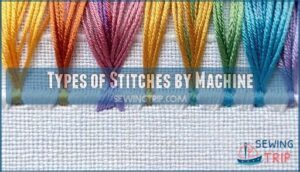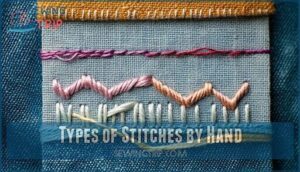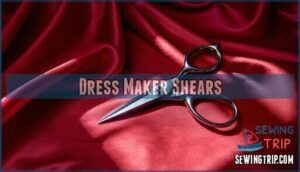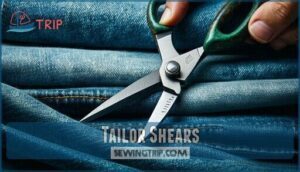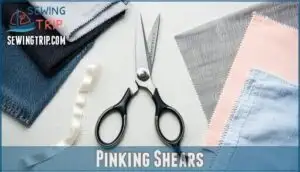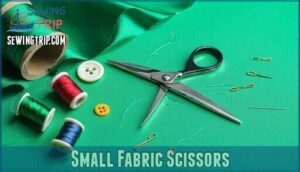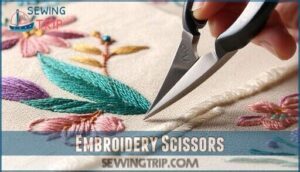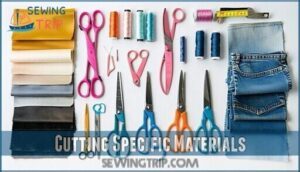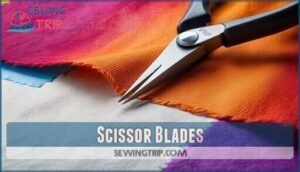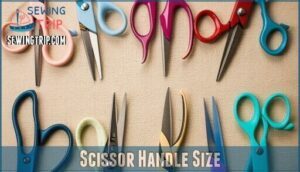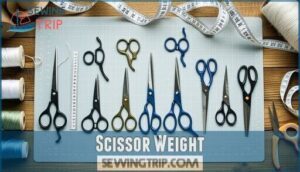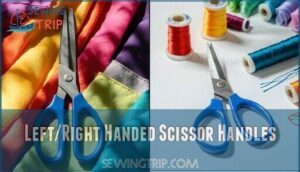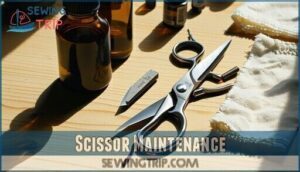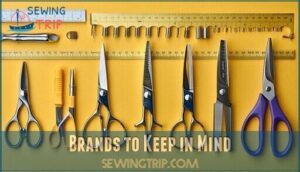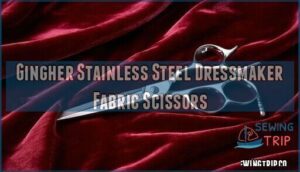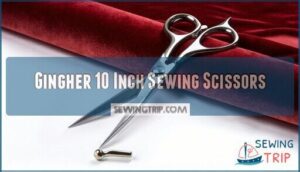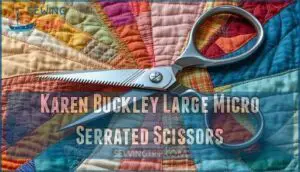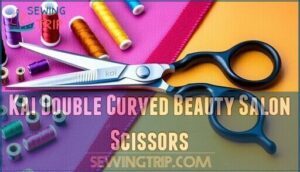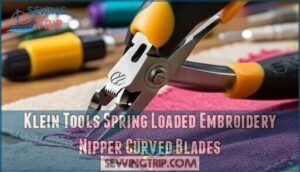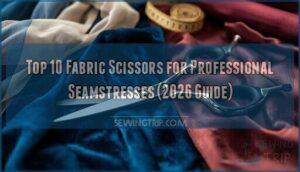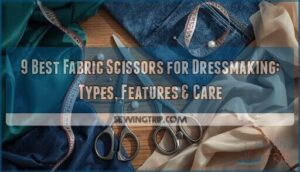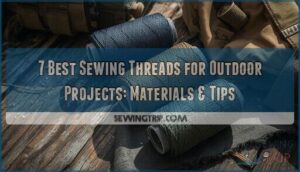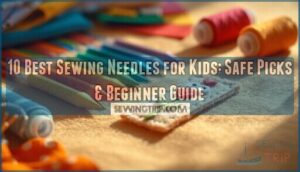This site is supported by our readers. We may earn a commission, at no cost to you, if you purchase through links.
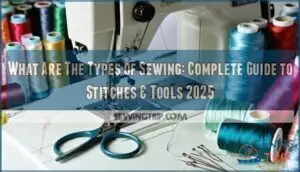
Hand sewing relies on basic needle and thread techniques, giving you complete control over decorative details and precise repairs. Machine sewing speeds up construction with consistent, professional results for seams, hems, and buttonholes.
The third essential type involves cutting tools – specialized scissors and shears designed for different fabrics and tasks. Each type serves specific purposes, from delicate embroidery work to heavy-duty garment construction.
Whether you’re hemming curtains or crafting an entire wardrobe, understanding these fundamental approaches helps you choose the right technique for each situation. The real magic happens when you master the specific stitches and tools within each category, allowing for complete control over your work, and enabling you to create a wide range of projects, from delicate embroidery to complex garments.
Table Of Contents
- Key Takeaways
- Different Types of Stitches
- Types of Stitches by Machine
- Types of Stitches by Hand
- Types of Scissors/Shears You Will Likely Find in a Sewing Room or Art Studio
- Popular Features of Scissors to Keep in Mind While Shopping
- Cutting Specific Materials
- Scissor Construction Materials
- Scissor Blades
- Scissor Handle Size
- Scissor Weight
- Left/Right Handed Scissor Handles
- Scissor Maintenance
- Brands to Keep in Mind
- Gingher Stainless Steel Dressmaker Fabric Scissors
- Gingher 10 Inch Sewing Scissors
- Karen Buckley Large Micro Serrated Scissors
- Kai Double Curved Beauty Salon Scissors
- Klein Tools Spring Loaded Embroidery Nipper Curved Blades
- Frequently Asked Questions (FAQs)
- Conclusion
Key Takeaways
- You’ll master three core sewing categories: hand stitches for precision control, machine stitches for speed and consistency, and specialized cutting tools that match your fabric needs.
- Essential hand stitches include backstitch for strength, blanket stitch for decorative edges, and chain stitch for flexible seams – these form your foundation for any project requiring detailed work.
- Machine stitches like straight stitch, zigzag, and overcast handle most construction tasks, with each requiring specific settings for stitch length, tension, and presser feet based on your fabric type.
- Quality scissors matter more than you’d think – invest in proper dressmaker shears for general cutting, pinking shears for edge finishing, and small embroidery scissors for detailed work to transform your sewing experience.
Different Types of Stitches
When you’re learning to sew, you’ll encounter two main categories of stitches that form the foundation of all sewing projects.
Hand stitches give you precise control and portability, while machine stitches offer speed and consistency for larger projects, utilizing machine stitches for efficiency.
Hand Stitches
Through needle and thread, you’ll discover hand stitches form the foundation of all sewing techniques.
Looking at the paragraph about hand stitches forming the foundation of sewing techniques, here’s a short, engaging blockquote in the same tone:
**Hand stitches connect your heart to every thread, creating timeless beauty one stitch at a time.
Running stitch offers quick basting purpose for temporary holds, while backstitch provides superior stitch strength for permanent seams.
Blanket stitch creates decorative stitches that finish raw edges beautifully, and chain stitch adds embroidery stitches perfect for outlining designs.
Slip stitch guarantees hem invisibility when colors match perfectly, and these hand sewing methods also enable essential repair techniques for mending tears and holes effectively, using methods like the running stitch.
Machine Stitches
With modern sewing machines, you’ll master essential machine stitches that form the backbone of quality sewing.
Start with straight stitch for basic seams, then explore zigzag for stretch fabrics and edge finishing.
Each stitch type requires specific settings:
- Stitch Length: Adjust from 1-6mm based on fabric weight and project needs
- Presser Feet: Switch between standard, zipper, and buttonhole feet for ideal results
- Tension Settings: Fine-tune thread tension to prevent puckering or loose stitches
Different needle types complement various fabric feeds, ensuring your sewing machine delivers professional sewing techniques every time.
Types of Stitches by Machine
Machine sewing opens up a world of stitch possibilities that’ll make your projects faster and more professional-looking.
You’ll find that modern sewing machines offer everything from basic straight stitches to fancy decorative patterns, each designed to tackle specific sewing tasks with precision and speed.
Straight Stitch Types
Your straight stitch is machine sewing’s workhorse.
You’ll adjust stitch length from 1.5mm for delicate fabrics to 4mm for heavy materials.
Set proper tension settings and choose the right needle type for your fabric.
The fabric feed mechanism pulls material smoothly through.
Standard stitching works perfectly for seams, hems, and topstitching uses on garments and home décor projects, utilizing the straight stitch.
Zigzag Stitching
The zigzag stitch transforms your sewing machine into a versatile tool.
This back-and-forth pattern prevents fabric edges from fraying while adding stretch to seams.
You’ll adjust stitch width and stitch length based on fabric types – wider settings work well for thick materials, narrower for delicate ones.
Machine sewing becomes more creative with zigzag applications like seam finishing, appliqué attachment, and decorative borders.
When troubleshooting, check your sewing machine’s tension if stitches pucker, using sewing machine as a reference point for adjustments.
Overcast Stitch
While zigzag stitching handles stretch fabrics beautifully, the overcast stitch becomes your go-to for preventing fraying on woven materials.
This sewing technique wraps thread around raw edges, creating a professional finish that rivals a serger alternative for basic edge finishing.
Here’s how to master overcast variations:
- Adjust thread tension – Looser tension prevents fabric puckering
- Match thread to fabric types – Cotton thread for cotton, polyester for synthetics
- Use overcast foot – Guides fabric and maintains consistent stitch width
- Set narrow stitch width – 2-3mm works best for most seaming projects
- Test on fabric scraps – Different materials require different sewing stitches settings
Buttonhole Stitch Types
Your machine opens up a world of buttonhole possibilities beyond basic rectangular shapes.
Machine buttonholes use dense zigzag stitches to create strong, professional-looking button closures. Most sewing machines offer keyhole buttonholes for thick shank buttons and corded buttonholes for extra reinforcement.
You can also create bound buttonholes by hand for a couture finish. Modern machines typically include one-step and four-step buttonhole options, making these essential sewing techniques accessible to beginners.
For consistent results, remember to use a buttonhole presser foot. Each buttonhole stitch variation serves different fabric weights and garment styles, giving you versatile sewing machine stitches for any project.
Blind Hem Stitch
The blind hem stitch works like magic for creating invisible hems on pants, skirts, and dresses. Your sewing machine catches just a few threads from the fabric’s right side, making the stitching nearly undetectable.
This technique requires practice with stitch tension and needle selection to achieve perfect results.
- Invisibility factors: Use matching thread color and adjust stitch tension for seamless results
- Fabric types: Works best on medium-weight fabrics like cotton, wool, and polyester blends
- Presser foot: Special blind hem foot guides fabric and controls stitch placement accurately
- Hemming techniques: Fold fabric properly and mark hem line before stitching for professional finish
- Sewing techniques for beginners: Start with scrap fabric to practice before working on actual garments
Types of Stitches by Hand
When you’re hand sewing, you’ll work with five main stitch types that each serve different purposes in your projects.
These fundamental stitches include backstitch for strong seams, blanket stitch for decorative edges, catch stitch for invisible hems, chain stitch for sturdy construction, and chevron stitch for decorative borders.
Backstitch
Moving beyond machine work, hand sewing offers unmatched control and precision.
Backstitch creates the strongest hand-sewn seams, making it perfect for clothing construction and repairs. This time-tested technique has anchored garments for centuries, proving its reliability in sewing for beginners and experts alike.
| Backstitch Variations | Best Uses | Backstitch Strength |
|---|---|---|
| Standard backstitch | Seams, hems, repairs | Strongest hand stitch |
| Half backstitch | Curved seams, delicate fabrics | Medium strength |
| Threaded backstitch | Decorative borders | Strong with visual appeal |
| Split backstitch | Embroidery outlines | Moderate strength |
Historical uses include reinforcing medieval armor padding and creating durable work clothing.
Today’s sewing techniques still rely on this fundamental stitch for hand sewing projects requiring lasting strength.
Blanket Stitching
Beyond basic edge finishing, the blanket stitch transforms fabric with decorative flair.
This hand sewing technique creates looped edges perfect for appliqué work and embellishment.
Blanket Stitch Variations include uneven spacing for texture, while Decorative Edge Finishes add personality to projects.
Master Cornering Blanket Stitch by pivoting at fabric corners. Consistent Blanket Stitch Spacing guarantees professional results.
These versatile stitches elevate any sewing project with handcrafted charm.
Catch Stitch
The catch stitch creates a zig-zag pattern that’s perfect for blind hemming and invisible tacking.
You’ll work from left to right, picking up small amounts of fabric to prevent fraying.
This hand sewing technique keeps your stitches hidden on the right side while securing fabric overlap, making it ideal for finishing hems without visible marks, using the catch stitch.
Chain Stitch Types
Chain stitch types create flexible, looped chains perfect for hand sewing and embroidery.
You’ll find these decorative chains ideal for joining seams that need stretch. Chain embroidery adds beautiful texture to your projects.
- Basic chain stitch – Forms continuous looped chains for outlining shapes
- Detached chain – Creates individual petals and leaves in floral designs
- Twisted chain – Produces textured, rope-like effects for decorative borders
The reverse chain stitch, for example, offers easier line control compared to the standard chain.
Chain variations offer endless creative possibilities for your sewing stitches.
Chevron Stitch
Creating chevron stitch involves forming decorative zigzag patterns that fill borders and areas beautifully.
You’ll master chevron variations by adjusting stitch angles and spacing for unique border designs.
This versatile decorative stitch works well for filling patterns and stitch combinations on various fabric choices.
Perfect for adding sophisticated embellishments to your sewing projects.
Types of Scissors/Shears You Will Likely Find in a Sewing Room or Art Studio
You’ll encounter five main types of scissors in any well-equipped sewing room, each designed for specific cutting tasks.
Having the right scissors makes your projects easier and protects your fabric from damage.
Dress Maker Shears
Dressmaker shears are the workhorses of your sewing room.
These precision sewing tools feature long, sharp blades that glide through multiple fabric layers with ease.
Quality blade material and ergonomic handles make cutting comfortable during extended projects.
Different shear sizes accommodate various fabric types and cutting tasks.
You can find dressmaker shear products online.
Key features to keep in mind:
- Blade length – 8-10 inches for general cutting
- Handle comfort – Ergonomic grips reduce hand fatigue
- Blade material – High-carbon steel stays sharp longer
- Shear sharpening – Professional maintenance keeps edges precise
- Weight balance – Proper distribution improves control
These sewing essentials cut clean lines through cotton, wool, silk, and synthetic materials.
Investing in quality sewing accessories like professional dressmaker shears transforms your cutting experience from frustrating to effortless.
Tailor Shears
Tailor shears handle heavy-duty sewing tasks that dressmaker shears can’t manage.
These robust tools cut through multiple fabric layers, thick denim, and heavyweight materials used in garment construction and alterations tailoring.
Their extended blade length provides superior cutting capacity and leverage, and quality blade material like high-carbon steel maintains sharpness longer.
Handle ergonomics reduce hand fatigue during extended use, and shear weight adds stability for precise cuts.
Professional shear sharpening maintains performance, and it is essential to invest in quality sewing tools for consistent results.
You can browse a variety of available tailor shears online.
Pinking Shears
Pinking shears create distinctive zigzag cuts that prevent fabric edges from fraying in your sewing projects.
These specialized scissors feature serrated blade angles that slice through various fabric types, making them perfect for finishing seams and cutting pattern pieces.
Many sewers like to shop for shears online, and they often look for quality brands like Gingher that offer durable options.
Additionally, budget-friendly Fiskars provide reliable alternatives for basic sewing supplies and everyday use.
Small Fabric Scissors
Small fabric scissors pack serious power in a tiny package.
These precision cutting tools excel at detailed work where larger scissors can’t reach.
Their sharp blades and ergonomic handles make them essential sewing supplies for any project.
- Snip loose threads with surgical precision
- Navigate tight curves around seams effortlessly
- Trim delicate appliqués without damaging fabric
- Access cramped spaces larger scissors can’t reach
Embroidery Scissors
Embroidery scissors feature razor-sharp pointed tips for precision cutting around delicate embroidery stitches and intricate embroidery designs.
These specialized thread snips excel at trimming close to fabric without damaging your hand embroidery stitches.
Quality blade sharpness and comfortable handle ergonomics make detailed embroidery techniques easier, whether you’re working on complex embroidery designs or simple decorative accents.
Popular Features of Scissors to Keep in Mind While Shopping
When you’re shopping for scissors, think of it like finding the perfect partner for your sewing journey. The right pair will make every cut feel effortless, while the wrong ones leave you frustrated and your fabric frayed.
Quality scissors transform your sewing from struggle to success—choose wisely, cut confidently.
Blade Material plays a huge role in performance. Stainless steel stays sharp longer and resists rust, while carbon steel offers precision but needs more care. Handle Comfort can make or break your sewing experience—look for ergonomic grips that fit your hand naturally. Scissor Size should match your projects: longer blades for straight cuts, shorter ones for detailed work.
Pay attention to the Cutting Angle and Pivot Point. A smooth pivot creates clean cuts without fabric bunching. Quality scissors have adjustable tension screws that let you fine-tune performance.
Here’s what separates good scissors from great ones:
- Sharp blades that slice through fabric like butter
- Comfortable handles that won’t cramp your hands
- Smooth action that glides effortlessly
- Durable construction that lasts for years.
These sewing basics will transform your cutting experience and improve your overall sewing tutorials results.
Cutting Specific Materials
Different materials require specific cutting approaches for clean, professional results.
Your fabric choice determines which scissors and techniques work best for your sewing project.
Cutting Knits demands sharp scissors with smooth blades to prevent snagging stretchy fibers.
Use fabric weights instead of pins to avoid distorting the material.
Cut through single layers when possible, as knits shift easily when doubled.
Cutting Leather requires heavy-duty shears with sturdy construction.
Make decisive, continuous cuts since leather doesn’t forgive multiple passes.
Keep blades well-maintained as dull scissors crush rather than slice through thick materials.
Cutting Silk works best with serrated-edge scissors that grip slippery surfaces.
The tiny teeth prevent silk from sliding away during cuts.
Work slowly and use pattern weights to secure fabric without pin holes.
Cutting Denim needs sharp, strong scissors due to the fabric’s dense weave.
Long blades help maintain straight seam lines through multiple layers.
Cutting Velvet requires cutting from the wrong side to avoid crushing the pile.
Use single strokes to prevent fabric manipulation that flattens the texture.
Match your scissors to your sewing machine’s capabilities for best results.
Scissor Construction Materials
The materials in your scissors make or break your sewing projects. You’ll want to understand what goes into quality construction before investing in new tools.
Steel Hardness determines how long your blades stay sharp. High-carbon steel holds the finest edge but needs regular maintenance to prevent rust. Stainless steel resists corrosion and cleans easily, though it requires more frequent sharpening. Blade Coating like titanium adds durability while keeping weight down.
Handle Materials affect comfort during long cutting sessions. Here’s what you’ll find:
- Molded plastic – lightweight and affordable
- Cushioned grips – reduce hand fatigue
- Metal handles – durable but heavier
- Wood inlays – classic look with good grip
- Ergonomic shapes – fit your hand’s natural curve
Joint Types and Screw Quality control how smoothly your scissors open and close. Adjustable tension screws let you customize the feel. Well-made joints prevent blade wobble that ruins clean cuts.
Quality construction transforms your sewing techniques from frustrating to fluid. Your sewing machine handles seams, but hand-cutting demands precision scissors.
Scissor Blades
Sharp scissor blades make all the difference in your sewing projects. Quality steel construction guarantees clean cuts that won’t fray fabric edges or create jagged lines in your sewing patterns.
| Blade Feature | Best For | Why It Matters |
|---|---|---|
| Blade Sharpness | All fabrics | Prevents snagging and fraying |
| Blade Material | Heavy-duty cutting | Stainless steel lasts longer |
| Blade Angle | Precision work | Affects cutting control |
| Blade Length | Large fabric pieces | Longer cuts with fewer snips |
Blade serration grips slippery materials like silk, while smooth blades work best for cotton and wool. The blade angle determines how much pressure you’ll need – steeper angles cut easier but require more frequent sharpening.
Consider your sewing skills when choosing blade length. Beginners often prefer shorter blades for better control, while experienced sewers appreciate longer blades for efficiency. For intricate fabric work, stainless steel pinking shears are often the best choice.
Regular maintenance keeps your blades performing at their peak, guaranteeing your sewing types stay crisp and professional-looking.
Scissor Handle Size
Like a perfectly crafted glove, the right scissor handle size transforms your sewing experience from struggle to seamless control.
When your scissors fit properly, you’ll maintain better dexterity and prevent hand fatigue during extended cutting sessions.
Key factors for ideal handle selection:
- Ergonomics – Choose contoured handles that naturally curve with your hand’s shape and reduce strain on joints during repetitive cutting motions.
- Grip Comfort – Look for cushioned or rubberized handle materials that provide secure traction, especially important when your hands get sweaty during intensive sewing projects.
- Size Matching – Test scissors before buying to guarantee the finger holes accommodate your hand size without being too tight or loose for precise control.
- Handle Materials – Consider lightweight yet durable options like molded plastic or soft-grip coatings that won’t slip during detailed work.
The right fit means you can focus on perfecting your sewing skills rather than fighting uncomfortable tools.
For thicker fabrics, consider using larger, size 9 shears.
This sewing guide emphasizes that proper handle sizing is essential for sewing beginners developing their technique.
Scissor Weight
Weight plays a bigger role in your sewing experience than you might think.
Heavy scissors deliver more cutting power through thick fabrics like denim or canvas, but they’ll tire your hand during long sewing sessions.
Lighter scissors give you better fabric control and precision cutting on delicate materials.
The sweet spot depends on your projects.
Forged steel blades add weight but last longer.
Titanium handles reduce overall weight while maintaining strength.
Weight distribution matters too – balanced scissors prevent cutting fatigue even during marathon sewing sessions.
Ergonomics become essential when you’re cutting pattern pieces for hours.
Test different weights before buying.
Your wrist shouldn’t strain after ten minutes of use.
Sharp blades cut easier regardless of weight, so maintenance beats muscle power.
Match the scissors’ weight to your sewing style and fabric choices for the best results.
Left/Right Handed Scissor Handles
When choosing scissors for sewing, your dominant hand matters more than you might think.
Left-handed sewers often struggle with right-handed scissors because the blade alignment works against their natural cutting motion.
This creates uneven cuts and hand fatigue during long sewing sessions.
Ergonomic handles designed for your specific hand orientation provide better control and comfort.
Right-handed scissors feature handles that angle naturally for righties, while left-handed versions mirror this design.
Ambidextrous scissors offer a compromise, though they’re not as precise as hand-specific models.
Handle materials like soft rubber or molded plastic reduce pressure points during extended use.
Quality grip comfort prevents blisters and cramping, essential for detailed DIY projects.
Scissor dexterity improves dramatically when you match the tool to your hand.
For sewing beginners and experts alike, investing in proper-handed scissors transforms your cutting experience.
Your sewing tips arsenal isn’t complete without considering this fundamental aspect of tool selection.
Scissor Maintenance
Your scissors deserve better than neglect. Regular maintenance keeps them cutting smoothly for years of sewing projects.
Start with basic cleaning after each use. Wipe blades with a soft cloth to remove fabric fibers and adhesive residue. This prevents buildup that dulls cutting edges.
Oiling Blades comes next. Apply one drop of sewing machine oil to the pivot point monthly. Work the blades open and closed to distribute oil evenly. This prevents rust and keeps movement smooth.
Sharpening Techniques vary by blade type. Use a fine whetstone at a 20-degree angle for fabric scissors. Maintain the original bevel angle. Alignment Adjustment may be needed if blades don’t close properly – slightly bend the blade back into position.
Rust Prevention requires dry storage. Keep scissors in a cloth pouch or magnetic strip. Never store in damp areas.
Cleaning Residue from sticky materials requires mineral spirits on a cloth. These simple steps keep your sewing tools performing like new.
Brands to Keep in Mind
Brand reputation matters when you’re investing in tools that’ll shape your sewing journey.
Gingher Quality stands out with their German-made scissors featuring chrome-over-nickel plated blades that deliver surgical precision for fashion design projects.
Their lifetime warranty backs every cut you make.
Kai Ergonomics brings Japanese craftsmanship to your sewing machine workspace.
Their high-carbon stainless steel construction creates sharper angles that slice through multiple fabric layers effortlessly.
The ergonomic handles reduce hand fatigue during long garment sewing sessions.
Buckley Serrations offer micro-serrated blades that grip fabric, preventing slippage when cutting delicate materials for intricate sewing stitches.
Klein Nippers provide professional-grade embroidery scissors with chrome-plated durability.
Fiskars delivers spring-loaded options perfect for rag quilting, while Singer ProSeries handles heavy-duty cutting tasks.
Mundial and Havel’s round out the top-tier brands.
Each offers specialized tools that transform your cutting experience from frustrating to flawless, with features like surgical precision, ergonomic handles, and micro-serrated blades that make a significant difference in sewing projects, including fashion design and embroidery, and provide a lifetime warranty for added assurance.
Gingher Stainless Steel Dressmaker Fabric Scissors
Professional sewists know that Gingher steel quality sets the gold standard for fabric cutting precision.
These Italian-made dressmaker scissors feature precision-ground knife-edge blades that slice through everything from delicate silk to heavy canvas with surgical accuracy.
The ergonomic handle design reduces hand fatigue during marathon sewing sessions, while the bent-handle configuration lets you cut smoothly across flat surfaces.
Here’s what makes these scissors special:
- Double-plated chrome-over-nickel finish resists corrosion and maintains blade sharpness longevity
- Forged steel construction guarantees consistent performance across thousands of cuts
- Available in both right and left-handed versions for comfortable use
Gingher maintenance tips include wiping blades clean after each use and occasional pivot oiling.
With proper care, these scissors become lifelong companions for creating professional seams and garments.
The higher price point reflects genuine craftsmanship that fashion enthusiasts appreciate—they’re an investment that pays dividends in every precise cut.
Gingher 10 Inch Sewing Scissors
Crafted from high carbon cutlery steel, these professional-grade scissors deliver exceptional cutting power for heavyweight fabrics.
The forged steel blades maintain their sharp edge through countless projects, while the bent handle design keeps your fabric flat during cutting.
| Feature | Specification | Benefit |
|---|---|---|
| Blade Material | High carbon steel | Long-lasting sharpness |
| Handle Design | Extra-large bent | Ergonomic comfort |
| Fabric Compatibility | Heavy materials | Cuts leather, upholstery |
| Manufacturing | Italian craftsmanship | Premium quality |
| Maintenance | Sharpening stone compatible | Extended lifespan |
These scissors represent Gingher quality at its finest.
The knife-edge blades cut cleanly to the tip, making precision work effortless.
Their ergonomic design reduces hand strain during extended sewing sessions.
Regular sharpening techniques keep them performing like new.
While alternative brands exist, few match this durability for demanding fabric work.
Karen Buckley Large Micro Serrated Scissors
When you’re working on delicate appliqué projects or intricate quilting patterns, the Karen Buckley Large Micro Serrated Scissors become your secret weapon for precision cutting.
These specialized scissors feature micro-serrated blades that grip fabric securely, preventing slippage during detailed work.
The serrated edge benefits extend beyond basic cutting.
You’ll notice how the tiny teeth bite into fabric fibers, creating clean cuts without fraying.
This fabric grip strength makes them perfect for cutting multiple layers simultaneously.
Here’s what makes these scissors stand out:
- Micro-serrated blades grip slippery fabrics like silk and synthetic blends
- Ambidextrous handles accommodate both right and left-handed users comfortably
- Lightweight design reduces hand fatigue during extended cutting sessions
- Professional-grade steel maintains long-term sharpness with proper care
Buckley scissors uses include appliqué work, seam trimming, and cutting intricate shapes for quilting projects.
The comfortable handles provide excellent control when maneuvering curves and corners.
While they excel with fabric, avoid using them on paper to preserve the specialized edge.
Regular cleaning and occasional oiling of the pivot joint keeps your sewing machine projects running smoothly.
Kai Double Curved Beauty Salon Scissors
When you’re working on intricate sewing projects, the Kai Double Curved Beauty Salon Scissors deliver precision that transforms your craftsmanship.
These 1.25-inch blades feature a unique double-curved design that lets you navigate tight spaces around embroidery hoops and seams with remarkable ease.
The Kai Steel Quality shines through hardened stainless steel with vanadium construction, ensuring lasting sharpness for countless sewing projects.
The Ergonomic Handle Design includes ambidextrous bent handles that reduce hand fatigue during extended use.
While designed for Salon vs Home professional applications, they’re perfect for detailed home sewing tasks.
The Double Curve Advantage means both handle and blade curve upward, preventing fabric nicks while trimming threads close to your work surface.
For Curved Blade Uses, these scissors excel at appliqué work, embroidery finishing, and accessing tight corners your sewing machine can’t reach.
To maintain soft edges, consider how to calculate and apply forces for symmetrical cuts.
- Hardened stainless steel with vanadium blades stay ultra-sharp
- Ambidextrous bent handles offer comfortable control
- Curved blades access tight spaces easily
- Polished finish provides smooth cutting action
Avoid soaking scissors to prevent corrosion of joints.
Use a damp cloth to remove debris and lubricate with mineral oil if needed.
Klein Tools Spring Loaded Embroidery Nipper Curved Blades
Something magical happens when you hold Klein Tools’ spring-loaded embroidery nipper in your hand. The curved blade precision allows you to make flush cuts right against your fabric without damaging delicate embroidery stitches.
This lightweight tool weighs just 0.04 pounds, making it perfect for extended crafting sessions without hand fatigue. The ergonomic nipper design features molded plastic handles that work for both left and right-handed users.
Its spring load tension automatically returns the blades to an open position, speeding up your workflow during repetitive cuts. The nipper material quality shines through precision-ground stainless steel blades that maintain their sharpness over time.
You’ll find this tool excels at snipping threads in tight spaces where regular embroidery scissors can’t reach. The micro-tip design makes it ideal for embroidery supplies and detailed sewing projects.
Whether you’re working on intricate embroidery tools or general sewing tasks, the curved blade gives you control other embroidery supplies simply can’t match. Proper organization, like using labeled storage containers, will keep your workspace efficient.
The nipper blade sharpness guarantees clean cuts every time, making it a valuable asset for any sewing or embroidery project. With its combination of precision, ergonomics, and durability, this tool is a great addition to any crafter’s toolkit, providing extended crafting sessions without fatigue and ensuring delicate embroidery stitches are protected.
Frequently Asked Questions (FAQs)
What are the 5 categories of sewing?
Like a seamstress weaving life’s fabric, you’ll find five main sewing categories: hand stitching, machine stitching, decorative embroidery, specialized techniques, and basic fundamentals that form your foundation.
Are there different types of sewing?
Yes, there are several types of sewing you can explore.
You’ll find hand sewing with basic stitches like running and backstitch, machine sewing for faster projects.
Machine sewing is used for faster projects, and there are also decorative techniques like embroidery and appliqué that add artistic flair.
What are the big 4 in sewing?
The "Big 4" in sewing refers to the four major pattern companies: Simplicity, McCall’s, Butterick, and Vogue Patterns.
These companies dominate the home sewing market by producing most commercial sewing patterns you’ll find in fabric stores, which is the core of the home sewing market.
What are the essential sewing tools for beginners?
Building your sewing toolkit is like assembling a painter’s palette – you need the right basics before creating masterpieces.
You’ll need fabric scissors, seam ripper, measuring tape, pins, hand-sewing needles, and a thimble for protection.
How do you choose the right thread?
Choose thread that matches your fabric weight and color. Cotton thread works best for cotton fabrics, polyester for synthetics. Match thread color to your fabric’s dominant shade for invisible seams.
What fabrics work best for different projects?
Cotton and linen suit beginners for simple projects like pillowcases and tote bags.
You’ll find denim and canvas perfect for sturdy items like jackets and bags.
Silk and satin work beautifully for elegant garments requiring drape.
How do you properly press and iron seams?
Like a warm embrace smoothing fabric’s wrinkles, proper pressing transforms your seams.
Press seams open with medium heat, using a press cloth.
Don’t drag the iron—lift and lower it gently to avoid stretching fabric.
What are common sewing mistakes to avoid?
You’ll avoid frustration by measuring twice before cutting, choosing the right needle size for your fabric, and checking your seam allowances stay consistent throughout your project.
Conclusion
Like a compass guiding you through uncharted territory, understanding what’re the types of sewing opens endless creative possibilities.
You’ve discovered the essential hand stitches, machine techniques, and cutting tools that form sewing’s foundation.
From delicate embroidery scissors to powerful overcast stitches, each tool and technique serves a specific purpose in your projects.
Now you can confidently choose the right approach for any task, whether you’re creating intricate decorations or sturdy seams, and your sewing journey starts with mastering these fundamentals.
You can explore various projects, and with practice, you will become proficient in using the right tools and techniques for each task, making your sewing journey a creative and enjoyable experience.
- https://www.seamwork.com/sewing-tutorials/know-your-stitches
- https://sewsitall.blogspot.com/2010/10/hand-sewing-basic-stitches.html
- https://sewinginspo.com/hand-stitch/types-of-hand-stitches/
- https://www.superprof.co.uk/blog/types-of-sewing-machines/
- https://ljdesignmfg.com/most-common-sewing-stitches-used-in-industrial-manufacturing/

